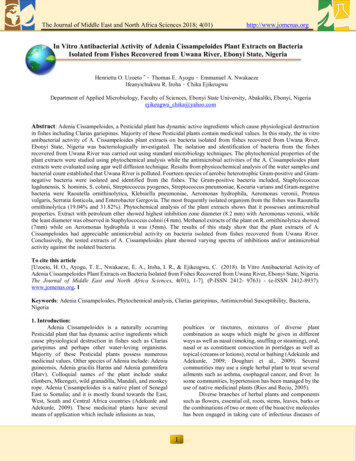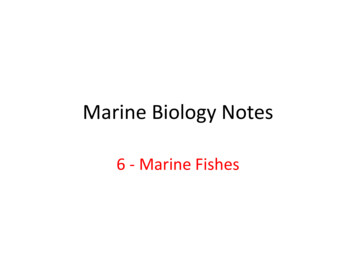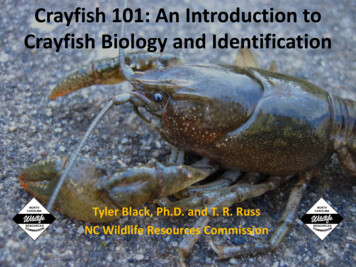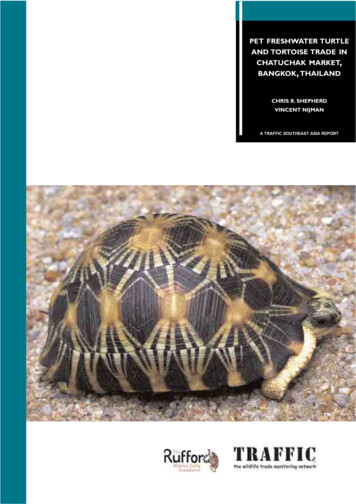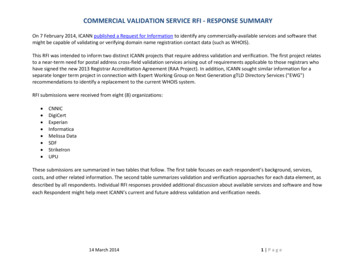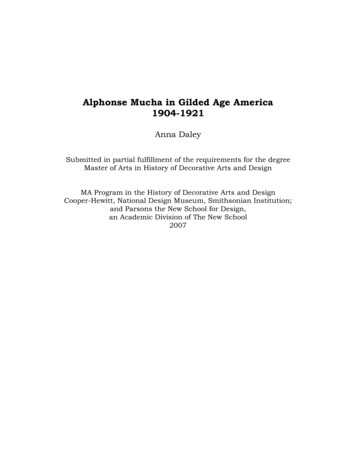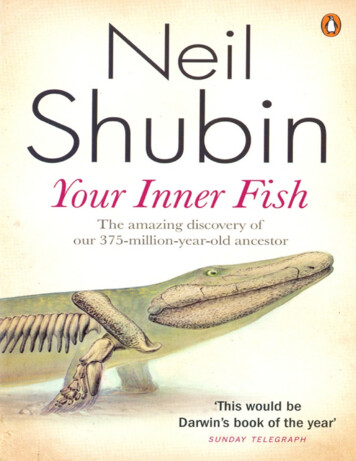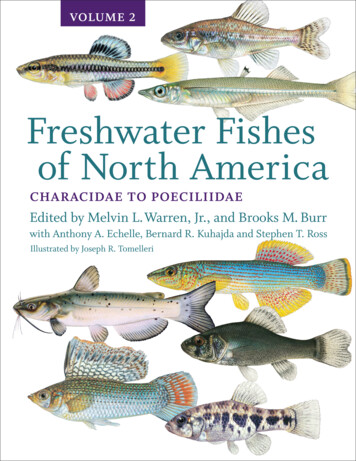
Transcription
Freshwater Fishes of North America 2019 The Johns Hopkins University Press UNCORRECTED PROOFDo not quote for publication until verified with finished book All rights reserved. No portion of this may be reproduced or distributed without permission.NOT FOR SALE OR DISTRIBUTION349-82339 Warren ch00 1P.indd 110/24/19 10:32 PM
Freshwater Fishesof North AmericaVOLUME 2Characidae to PoeciliidaeEdited by Melvin L. Warren, Jr.,and Brooks M. BurrWith Anthony A. Echelle, Bernard R. Kuhajda,and Stephen T. RossIllustrated by Joseph R. TomelleriJohns Hopkins University PressBALTIMORE 2019 The Johns Hopkins University Press UNCORRECTED PROOFDo not quote for publication until verified with finished book All rights reserved. No portion of this may be reproduced or distributed without permission.NOT FOR SALE OR DISTRIBUTION349-82339 Warren ch00 1P.indd 310/24/19 10:32 PM
This page intentionally left blank
Freshwater Fishesof North AmericaVOLUME 2Characidae to PoeciliidaeEdited by Melvin L. Warren, Jr.,and Brooks M. BurrWith Anthony A. Echelle, Bernard R. Kuhajda,and Stephen T. RossIllustrated by Joseph R. TomelleriJohns Hopkins University PressBALTIMORE 2019 The Johns Hopkins University Press UNCORRECTED PROOFDo not quote for publication until verified with finished book All rights reserved. No portion of this may be reproduced or distributed without permission.NOT FOR SALE OR DISTRIBUTION349-82339 Warren ch00 1P.indd 310/24/19 10:32 PM
2020 Johns Hopkins University PressAll rights reserved. Published 2020Printed in China on acid-free paper9 8 7 6 5 4 3 2 1Johns Hopkins University Press2715 North Charles StreetBaltimore, Maryland 21218-4363www.press.jhu.eduLibrary of Congress Cataloging-in-Publication DataFreshwater fishes of North America / edited by Melvin L. Warren, Jr., and Brooks M. Burr ;illustrated by Joseph R. Tomelleri.volumes cmIncludes bibliographical references and index.ISBN-13: 978-1-4214-1201-6 (hardcover : alk. paper)ISBN-13: 978-1-4214-1202-3 (electronic)ISBN-10: 1-4214-1201-2 (hardcover : alk. paper)ISBN-10: 1-4214-1202-0 (electronic)1. Freshwater fishes—North America. I. Warren, Melvin L., Jr., editor of compilation.II. Burr, Brooks M., editor of compilation.QL625.F74 2014597.176—dc232013015264ISBN-13: 978-1-4214-3512-1 (hardcover : alk. paper)ISBN-13: 978-1-4214-3513-8 (electronic)ISBN-10: 1-4214-3512-8 (hardcover : alk. paper)ISBN-10: 1-4214-3513-6 (electronic)A catalog record for this book is available from the British Library.Special discounts are available for bulk purchases of this book. For more information, pleasecontact Special Sales at 410-516-6936 or specialsales@press.jhu.edu.Johns Hopkins University Press uses environmentally friendly book materials, includingrecycled text paper that is composed of at least 30 percent post-consumer waste, wheneverpossible. 2019 The Johns Hopkins University Press UNCORRECTED PROOFDo not quote for publication until verified with finished book All rights reserved. No portion of this may be reproduced or distributed without permission.NOT FOR SALE OR DISTRIBUTION349-82339 Warren ch00 1P.indd 410/24/19 10:32 PM
Robert C. Cashner (1941–2018)Friend, teacher, mentor, leader,andstellar freshwater ichthyologist.We miss you, Bob. 2019 The Johns Hopkins University Press UNCORRECTED PROOFDo not quote for publication until verified with finished book All rights reserved. No portion of this may be reproduced or distributed without permission.NOT FOR SALE OR DISTRIBUTION349-82339 Warren ch00 1P.indd 510/24/19 10:32 PM
This page intentionally left blank
ContentsList of ContributorsixPrefacexiMelvin L. Warren, Jr., and Brooks M. BurrAcknowledgmentsChapter 14xixCharacidae: Characins1Norman Mercado-Silva, Claudia P. Ornelas-García, Juan Jacobo Schmitter-Soto,Nicholas J. Gidmark, and Andrew M. SimonsChapter 15Ictaluridae: North American Catfishes23Brooks M. Burr, Melvin L. Warren, Jr., and Micah G. BennettChapter 16Ariidae: Sea Catfishes101Matthew R. Thomas and Ricardo Betancur-R.Chapter 17Heptapteridae: Seven-finned Catfishes123Matthew R. Thomas and Mark Henry SabajChapter 18Osmeridae: Smelts149Robert L. Hopkins II and Melvin L. Warren, Jr.Chapter 19Esociformes: Esocidae, Pikes, and Umbridae (Mudminnows)193Frank H. McCormick, Terry Grande, Cheryl Theile, Melvin L. Warren, Jr., J. Andrés López,Mark V. H. Wilson, Roger A. Tabor, Julian D. Olden, and Lauren M. KuehneChapter 20Percopsidae: Trout-perches261Brooks M. Burr and Melvin L. Warren, Jr.Chapter 21Amblyopsidae: Cavefishes281Ginny L. Adams, Brooks M. Burr, and Melvin L. Warren, Jr.Chapter 22Aphredoderidae: Pirate Perches322Brooks M. Burr and Melvin L. Warren, Jr. 2019 The Johns Hopkins University Press UNCORRECTED PROOFDo not quote for publication until verified with finished book All rights reserved. No portion of this may be reproduced or distributed without permission.NOT FOR SALE OR DISTRIBUTION349-82339 Warren ch00 1P.indd 710/24/19 10:32 PM
viiiCOnTEnTsChapter 23Gadidae (Gadinae and Lotinae): Cods and Cuskfishes340Peter B. BerendzenChapter 24Mugilidae: Mullets367Steven L. PowersChapter 25Atherinopsidae: New World Silversides384Kyle R. Piller and Clyde D. BarbourChapter 26Beloniformes: Belonidae (Needlefishes) and Hemiramphidae (Halfbeaks)449Bruce B. Collette and Stephen J. WalshChapter 27Rivulidae: New World Rivulines463Ann M. Uzee O’Connell, Martin T. O’Connell, and Anthony A. EchelleChapter 28Profundulidae: Middle American Killifishes493Mollie F. Cashner and Anthony A. EchelleChapter 29Goodeidae: Goodeids503Shane A. WebbChapter 30Fundulidae: Topminnows549Robert C. Cashner, Jacob Schaefer, Melvin L. Warren, Jr., Anthony A. Echelle,Fernando Galvez, and Michael J. GhedottiChapter 31Cyprinodontidae: Pupfishes609Anthony A. Echelle and Alice F. EchelleChapter 32Poeciliidae: Livebearers674Michael J. Ghedotti, Matthew P. Davis, and Anthony A. EchelleLiterature Cited739Index of Scientific NamesGeneral Index889898 2019 The Johns Hopkins University Press UNCORRECTED PROOFDo not quote for publication until verified with finished book All rights reserved. No portion of this may be reproduced or distributed without permission.NOT FOR SALE OR DISTRIBUTION349-82339 Warren ch00 1P.indd 810/24/19 10:32 PM
ContributorsGinny L. AdamsUniversity of Central ArkansasMichael J. GhedottiRegis UniversitySteven L. PowersRoanoke CollegeClyde D. Barbour (retired)Wright UniversityNicholas J. GidmarkKnox CollegeMicah G. BennettU.S. Environmental Protection AgencyTerry GrandeLoyola University ChicagoMark Henry SabajThe Academy of Natural Sciencesof Drexel UniversityPeter B. BerendzenUniversity of Northern IowaRobert L. Hopkins IIUniversity of Rio GrandeRicardo Betancur-R.University of Puerto RicoLauren M. KuehneUniversity of WashingtonBrooks M. BurrSouthern Illinois UniversityJ. Andrés LópezUniversity of AlaskaMollie F. CashnerAustin Peay State UniversityFrank H. McCormickUSDA Forest Ser viceRobert C. Cashner (deceased)University of New OrleansNorman Mercado-SilvaUniversidad Autónoma del Estadode MorelosBruce B. ColletteNational Museum of Natural HistoryMatthew P. DavisSt. Cloud State UniversityAlice F. EchelleOklahoma State UniversityAnthony A. EchelleOklahoma State UniversityFernando GalvezLouisiana State UniversityAnn M. Uzee O’ConnellUniversity of New OrleansMartin T. O’ConnellUniversity of New OrleansJulian D. OldenUniversity of WashingtonClaudia P. Ornelas-GarcíaUniversidad Nacional Autónoma deMéxico Tercer Circuito ExteriorJacob SchaeferUniversity of Southern MississippiJuan Jacobo Schmitter-SotoEl Colegio de la Frontera SurAndrew M. SimonsUniversity of MinnesotaRoger A. TaborU.S. Fish and Wildlife Ser viceCheryl TheileLoyola University ChicagoMatthew R. ThomasKentucky Department of Fishand Wildlife ResourcesStephen J. WalshU.S. Geological SurveyMelvin L. Warren, Jr.USDA Forest Ser viceShane A. WebbUniversity of North GeorgiaMark V. H. Wilson (emeritus)University of AlbertaKyle R. PillerSoutheastern Louisiana University 2019 The Johns Hopkins University Press UNCORRECTED PROOFDo not quote for publication until verified with finished book All rights reserved. No portion of this may be reproduced or distributed without permission.NOT FOR SALE OR DISTRIBUTION349-82339 Warren ch00 1P.indd 910/24/19 10:32 PM
This page intentionally left blank
PrefaceThe North American freshwater fish fauna comprises 1,300 native species in about 50 families. It is the mostthoroughly studied and largest temperate fish fauna(Miller et al. 2005; Page & Burr 2011) in the world. Incomparison, an analysis and compendium of Europeanfreshwater fishes included 546 native species in about 24families (Kottelat & Freyhof 2007); Europe is about onethird the land area of North America. Australia has nearly300 freshwater fishes in 35 families (Allen 1989; Allenet al. 2002) in a land area about that of the United States(minus Alaska). This number includes many marine species that enter fresh water, and highly unusual freshwaterfish lineages occur there (e.g., Salamanderfish, Lepidogalaxias salamandroides; Australian Lungfish, Neoceratodusforsteri; and Nurseryfish, Kurtus gulliveri). The only othertemperate fish fauna that could rival North America isAsia (Lévêque et al. 2008), but reliable information onthis vast area and its fishes remains poorly understood byscientists in the New World. Estimates for the country ofChina range from 920 to 1,010 native species (Kang et al.2014; M. Kottelat pers. comm.). Unsurprisingly, as formany plant and animal groups, the tropical regions of theworld harbor freshwater fish faunas several times largerthan those of temperate regions (Lundberg et al. 2000;Agostinho et al. 2005; Berra 2007).In the mid-1970s, knowledge of North American freshwater fishes was confined to a few specialists, but even sofor many species (and families) little was available on natural history or ecology. In 1980 a landmark volume was published that used spot distribution maps to illustrate theranges of all freshwater fish species in the United Statesand Canada (Lee et al. 1980 et seq.). That volume madeavailable to the lay public as well as specialists a level ofknowledge of the North American freshwater fish faunatheretofore unknown. Shortly thereafter a physician fromForsythe, Missouri, combined his hobby of scuba divingand snorkeling with photography and revealed—new evento specialists—the incredible colors of the North Americannative fish fauna, especially in their brightest breeding condition, as well as some of their unique and fascinating natural histories. William N. Roston eventually traveled thecontinent looking for clear water and fish to photograph intheir natural environment (never in aquaria). A number ofhis photographs are used in this volume.From the 1970s through the 1990s numerous booksfocused on fish faunas of individual states (e.g., Alabama,Arkansas, California, Idaho, Illinois, Kansas, Mississippi,Missouri, New Mexico, Ohio, Tennessee, Virginia, Washington, West Virginia, and Wisconsin) as well as Canada,making even more detail on fishes available to the public.These works allowed for the first complete identificationguide to all freshwater fishes in the United States andCanada (Page & Burr 1991, revised 2011). Nevertheless, itwas not until the Freshwater Fishes of Mexico (Miller et al.2005, 2009) was published that it was possible for us toconsider editing this three-volume work on the naturalhistory, ecology, and conservation of North Americanfreshwater fishes. We are indebted to a large communityof ichthyologists, fisheries biologists, and other workers inrelated fields (e.g., genetics, physiology, behavior, ecology)who have investigated the details of the lives of fishes insuch a way that much technical information can now besynthesized in one place and again made available to thepublic and other specialists.Even though our overarching goal was to synthesize asmuch information as possible on North American freshwater 2019 The Johns Hopkins University Press UNCORRECTED PROOFDo not quote for publication until verified with finished book All rights reserved. No portion of this may be reproduced or distributed without permission.NOT FOR SALE OR DISTRIBUTION349-82339 Warren ch00 1P.indd 1110/24/19 10:32 PM
xiiPREFACEfishes, the job of gathering information is far from complete.In editing this work and writing synthesis chapters of ourown, we were struck at once by the incredible natural historyand taxonomic diversity among our native freshwater fishes,but also by the large and critical information gaps that remain. Unfortunately, for many species (and nearly entirefamilies), the syntheses presented here are (or are close to being) obituaries (e.g., Miller et al. 1989; Minckley & Deacon1991; Warren et al. 2000; Brouder & Scheurer 2007; Jelkset al. 2008; Burkhead 2012). For many species and groups,the biological information needed to help recover them, toslow population declines, or to prevent extinction is simplyunavailable. That said, the most critical component of conserving North American freshwater fishes is the preventionof habitat loss and degradation by humans, not the lack of biological information. Fishes in this fauna have an incredibletenacity for life, whether we completely understand theirbiology or not, but we as coinhabitants of the North American continent need to provide them the opportunity to endure. We hope that this work helps stem the high rates ofpopulation decline and extinction being experienced acrossthe North American fish fauna. We also hope this work stimulates a whole new generation of ichthyologists and fisheriesresearchers to further expand our knowledge and appreciation of the natural history, ecology, and conservation of thegreat freshwater fish fauna of North America.AREA AND BREADTH OF COVERAGEThe area of coverage encompasses fishes in fresh watersof North America, including Canada, the coterminousUnited States, and Mexico, south generally to the Isthmusof Tehuantepec. For some families, authors extended thesouthern boundary to include fishes of the Yucatan Peninsula region. Within the covered area, all native NorthAmerican fishes, emphasizing the level of genus, are included that primarily inhabit and reproduce in freshwater and that primarily inhabit marine or estuarine systems but are frequent or even permanent components ofsome freshwater fish assemblages. Some primarily marinefishes (across 11 families) are included because they arenaturally established and reproduce in fresh waters (e.g.,Atlantic Needlefish, Strongylura marina, Collette & Walsh,this volume). Others are included because young andadults penetrate deeply into freshwater systems and reproduce or are suspected of reproducing in fresh waters(e.g., Hogchoker, Trinectes maculatus), and still others simply occur with such high frequency in freshwater habitatsthat they likely are important functionally in those eco-systems (e.g., Striped Mullet, Mugil cephalus, Powers, thisvolume). Admittedly, some degree of arbitrariness was unavoidable in the inclusion or exclusion of marine speciesin a work about freshwater fishes, but the arbitrariness reflects a biologically real gray area among fishes at the interface of freshwater and saltwater systems (e.g., coastalLargemouth Bass, Micropterus salmoides; Gulf Pipefish,Syngnathus scovelli; Atlantic Needlefish, Strongylura marina, Collette & Walsh, this volume).Each taxonomic chapter focuses on a family or in somecases two families of North American freshwater fisheswith emphasis on the natural history, biology, evolution,and conservation of each genus in the family. Because ofthe timing of preparation of the volumes, the sequence ofthe families generally follows the arrangement of Pageet al. (2013), Nelson (2006), and Nelson et al. (2016), butwe acknowledge the phylogeny of Ray-finned Fishes andSpiny-rayed Fishes by Near et al. (2012b, 2013) and the expansion of that work by Betancur-R. et al. (2013ab, 2017)as the most comprehensive and defensible to date and present these sequences herein for North American fishes wecover (Tables P.1 and P.2). In Volume 1, taxonomic chapters covered the Lampreys (Petromyzontidae) through theSuckers (Catostomidae) with one exception. Taxonomicchapters in Volume 2 cover the Characins (Characidae)through the Livebearers (Poecilidae) with one exception,and in Volume 3, the Sticklebacks through the AmericanSoles (Achiriidae). Because of extenuating circumstances,the chapters on Herrings (Clupeidae; originally slated forVolume 1) and Trouts and Salmons (Salmonidae; originallyslated for Volume 2) will appear in Volume 3.METHODSSources. We encouraged authors to use only peerreviewed publications in this work, but in many cases, information was only available in unpublished dissertations,theses, or even reports. We clearly indicate those unpublished sources as such in the literature cited.Scientific and common names. For scientific and common names of taxa (e.g., species, genera, families, orders),we used Nelson (2006), Page et al. (2013), Nelson et al.(2016), and occasionally FishBase (Froese & Pauly 2019)as guides. Our order of presentation of families generallyfollows that of Nelson (2006), Page et al. (2013), andNelson et al. (2016), but as noted previously, Near et al.(2012b, 2013) presented a phylogeny of Ray-finned Fishes(Actinopterygii) and Spiny-rayed Fishes (Acanthomorpha)based on 9–10 nuclear genes and 579 fish species. Using 2019 The Johns Hopkins University Press UNCORRECTED PROOFDo not quote for publication until verified with finished book All rights reserved. No portion of this may be reproduced or distributed without permission.NOT FOR SALE OR DISTRIBUTION349-82339 Warren ch00 1P.indd 1210/24/19 10:32 PM
Table P.1. Phylogenetic sequence, clade names, orders, and family names of Ray-finned Fishes (Actinopterygii) and Spiny-rayedFishes (Acanthopterygii) represented in North American fresh waters. The sequence follows the phylogenetic trees recovered fromanalysis of 9–10 nuclear genes and 579 fish species (modified from Near et al. 2012b, 2013). The designation at the ordinal level ofincerti ordis indicates the broader relationships of the family are to date undefined.Clade NameOrder and Family (common enseridae (Sturgeons)Polyodontidae (Paddlefishes)NeopterygiiHolosteiAmiiformesAmiidae (Bowfins)LepisosteiformesLepisosteidae e (Freshwater rmesHiodontidae idae (Herrings)Engraulidae omidae (Suckers)Cyprinidae (Carps and Minnows)CharaciformesCharacidae (Characins)SiluriformesAriidae (Sea Catfishes)Heptapteridae (Seven-finned Catfishes)Ictaluridae (North American Catfishes)EuteleosteiSalmoniformesSalmonidae (Trouts and Salmons)EsociformesEsocidae (Pikes and Mudminnows)OsmeriformesOsmeridae homorphaPercopsiformesAmblyopsidae (Cavefishes)Aphredoderidae (Pirate Perches)Percopsidae (Trout-Perches)GadiformesGadidae (Cods)(continued)xiii 2019 The Johns Hopkins University Press UNCORRECTED PROOFDo not quote for publication until verified with finished book All rights reserved. No portion of this may be reproduced or distributed without permission.NOT FOR SALE OR DISTRIBUTION349-82339 Warren ch00 1P.indd 1310/24/19 10:32 PM
xivPREFACETable P.1, continuedClade NameOrder and Family (common nathidae (Pipefishes and Seahorses)GobiiformesGobiidae (Gobies)Eleotridae (Sleepers)SynbranchiformesSynbranchidae (Swamp Eels)PleuronectiformesAchiridae (American Soles)Paralichthyidae (Sand Flounders)Pleuronectidae (Righteye Flounders)OvalentariaAtheriniformesAtherinopsidae (New World Silversides)BeloniformesBelonidae (Needlefishes)Hemiramphidae (Halfbeaks)CyprinodontiformesRivulidae (New World Rivulines)Goodeidae (Goodeids)Profundulidae (Middle American Killifishes)Cyprinodontidae (Pupfishes)Fundulidae (Topminnows)Poeciliidae (Livebearers)incerti ordinisCichlidae (Cichlids and Tilapias)incerti ordinisMugilidae (Mullets)Embiotocidae (Surfperches)incerti ordinisGobiesocidae (Clingfishes)Unnamed cladeCentrarchiformesCentrarchidae (Sunfishes)PerciformesPercidae (Perches)Cottidae (Sculpins)Gasterosteidae (Sticklebacks)Unnamed cladeUnnamed cladeand expanding and updating the Near et al. (2013) data,Betancur-R. et al. (2013ab, 2017) analyzed relationships ofnearly 2,000 bony fish taxa using multi-locus trees. Theresults clearly indicate convergence on a well-resolvedphylogeny for most fishes. We accept those works as definitive (Tables P.1 and P.2) but did not follow that phylogenetic sequence because of timing of volume preparation.Authors give the complete scientific and common name inincerti ordinisMoronidae (Temperate Basses)incerti ordinisSciaenidae (Drums)the chapters on first mention of the species and thereafteruse either or both. Authors were free to deviate fromthese primary sources for common and scientific namesfor newly described species and higher taxa or because ofdiffering or new systematic evidence (or taxonomic opinion) as well as for clarity. We capitalized the commonnames, if available, of all species, families, orders, andhigher taxonomic categories (e.g., Ray-finned Fishes for 2019 The Johns Hopkins University Press UNCORRECTED PROOFDo not quote for publication until verified with finished book All rights reserved. No portion of this may be reproduced or distributed without permission.NOT FOR SALE OR DISTRIBUTION349-82339 Warren ch00 1P.indd 1410/24/19 10:32 PM
Table P.2. Phylogenetic classification of Ray-finned Fishes (Actinopterygii) represented in North American fresh waters. The sequencefollows the phylogenetic tree recovered from analysis of multiple locus DNA sequence data for nearly 2,000 fish taxa (Betancur-R.et al. 2013ab, 2017). The designation at the ordinal level of incerti ordinis indicates the broader relationships of the family are todate amily (common name)AcipenseriformesAcipenseridae (Sturgeons)Polyodontidae (Paddlefishes)Amiidae (Bowfins)Lepisosteidae nomorphaeCichlomorphaeAtherinomorphaeincerti rphaeMugiliformesGobiesociformesincerti ordinisincerti ordinisCentrarchiformesPerciformesAnguillidae (Freshwater Eels)Hiodontidae (Mooneyes)Clupeidae (Herrings)Engraulidae (Anchovies)Catostomidae (Suckers)Cyprinidae (Carps and Minnows)Characidae (Characins)Ariidae (Sea Catfishes)Heptapteridae (Seven-finned Catfishes)Ictaluridae (North American Catfishes)Salmonidae (Trouts and Salmons)Esocidae (Pikes)Umbridae (Mudminnows)Osmeridae (Smelts)Amblyopsidae (Cavefishes)Aphredoderidae (Pirate Perches)Percopsidae (Trout-perches)Gadidae (Cods and Cuskfishes)Eleotridae (Sleepers)Gobiidae (Gobies)Syngnathidae (Pipefishes and Seahorses)Synbranchidae (Swamp Eels)Achiridae (American Soles)Paralichthyidae (Sand Flounders)Pleuronectidae (Righteye Flounders)Embiotocidae (Surfperches)Atherinopsidae (New World Silversides)Cichlidae (Cichlids and Tilapias)Belonidae (Needlefishes)Hemiramphidae (Halfbeaks)Cyprinodontidae (Pupfishes)Fundulidae (Topminnows)Poeciliidae (Livebearers)Goodeidae (Goodeids)Profundulidae (Middle American Killifishes)“Rivulidae” (New World Rivulines)Mugilidae (Mullets)Gobiesocidae (Clingfishes)Moronidae (Temperate Basses)Sciaendae (Drums)Centrarchidae (Sunfishes)Elassomatidae (Pygmy Sunfishes)Percidae (Perches)Gasterosteidae (Sticklebacks)Cottidae (Sculpins)xv 2019 The Johns Hopkins University Press UNCORRECTED PROOFDo not quote for publication until verified with finished book All rights reserved. No portion of this may be reproduced or distributed without permission.NOT FOR SALE OR DISTRIBUTION349-82339 Warren ch00 1P.indd 1510/24/19 10:32 PM
xviPREFACEActinopterygii, Catfishes for Siluriformes, North American Catfishes for Ictaluridae, Channel Catfish for Ictaluruspunctatus) (see Nelson et al. 2002). We encouraged authors to use the common name in lieu of scientific namesafter first mention because common names are descriptive and colorful and are increasingly more stable throughtime than scientific names. We did not capitalize colloquial, nonstandard, or semi-technical, but informal, common names for groups of fish (e.g., bass, blackbass, brooklamprey, buffalo, bullhead, carp, carpsucker, chub, crappie, dace, darter, jumprock, killifish, madtom, minnow,molly, mosquitofish, pickerel, pikeminnow, piranha, redhorse, salmon, shad, shiner, splitfin, trout).Fossil taxa. We indicated fossil taxa by a dagger (†) placedbefore the genus name. In general, we followed Walkeret al. (2012) for designation of geologic time (period, epoch,age) in millions of years ago (mya), but the original references should be consulted to determine how the geologicalformations were dated or how fossil dates were estimated.Length abbreviations and museum acronyms. We abbreviated standard length (SL), total length (TL), and forklength (FL) throughout. Museum acronyms followedSabaj Pérez (2016).Distributional maps. We provided to authors shaded mapsfor each genus showing the estimated native freshwaterrange (unless indicated otherwise) of the genus in NorthAmerica. For genera with expansive marine ranges, thefreshwater and near-shore marine range is given, not the entire marine range. Although we took care to make the mapsas accurate as possible, the scale of the maps and shading ofthe range obviated pin-point accuracy. Also, for many fishesthat have been widely introduced, the native range can onlybe estimated from often limited historical data.TAXONOMIC CHAPTER ORGAN IZATIONEach taxonomic chapter contains 13 major sections andvarious numbers of subsections. For some families, littleto nothing may be known about certain sectional and subsectional topics, and in those cases, the paucity or lack ofinformation is generally acknowledged.Even in a work this large and broad ranging, we came torealize early on that some important topics could not becovered adequately when our focus was largely at the levelof genus. Hence, contributors did not cover the zoogeography of species within each family. The zoogeography ofNorth American freshwater fishes would require anothervolume to update and reassess information previously synthesized on that topic (e.g., Hocutt & Wiley 1986; Mayden1992; Ross 2013; Ross & Matthews 2014). Likewise, contributors did not include tools or aids in identification ofspecies (e.g., illustrated keys) because identification is mostoften a species-level exercise and it is so well covered innumerous state and regional fish books, including Canada(Scott & Crossman 1973) and Mexico (Miller et al. 2005,2009; see also literature guide sections in each taxonomicchapter) as well as in a field guide for North Americanfreshwater fishes north of Mexico (Page & Burr 2011). Another important, but large topic not covered in detail is thearea of fishing statistics, which again is deserving of a separate synthesis (see commercial importance sections forsome details). We describe the content of major sectionsand subsections in each chapter as follows:Chapter introduction. In an initial section, contributingauthors introduce the family to the reader by relating thescientific and common names of the fishes, highlightingsome specialized or unusual features of the group, and forthose families with a large number of marine species orthose not wholly endemic to fresh waters of North America, placing the focal taxa in context of the diversity andgeographic distribution of the entire family.Diversity and distribution. Contributing authors summarize the general diversity of the focal family, including adiscussion of each genus, its native distribution, the number of species in each genus, and evidence of polytypy orphylogeographic structure. Contributing authors also included a non-native distribution subsection, if information was available, outlining introductions outside thenative range and, if known, the effects of the taxa asnon-natives.Phylogenetic relationships. Contributing authors cover allphylogenetic hypotheses (those based on cladistic methodologies) for the focal family (inter- and intrafamilial) identifying, if possible, the sister-group of the family and thendetailing the relationships of all genera within the family.Fossil record. Contributing authors summarize the fossilhistory, if any, for the focal family. Minimally the sectionsynthesizes information on each known fossil genus inthe family and the number of extinct fossil species in eachgenus. Ages or approximate ages are given when known.Morphology. Contributing authors synthesize information on morphological structures with an emphasis ondiversity in morphology across family members and specialized, unusual, and unique features. In the introductory subsection, contributing authors describe the generalphysiognomy of the respective family (e.g., body shape; finshape, type, relative size, and placement; mouth size andplacement; scale type, color, and pigmentation patterns). 2019 The Johns Hopkins University Press UNCORRECTED PROOFDo not quote for publication until verified with finished book All rights reserved. No portion of this may be reproduced or distributed without permission.NOT FOR SALE OR DISTRIBUTION349-82339 Warren ch00 1P.indd 1610/24/19 10:32 PM
PREFACEIn other subsections, contributing authors detail unusua
Printed in China on acid-free paper 9 8 7 6 5 4 3 2 1 Johns Hopkins University Press 2715 North Charles Street Baltimore, Mary land 21218-4363 www. press. jhu. edu Library of Congress Cataloging- in-Publication Data Freshwater fishes of North Ameri ca / edited by MelvinL. Warren, Jr.,

